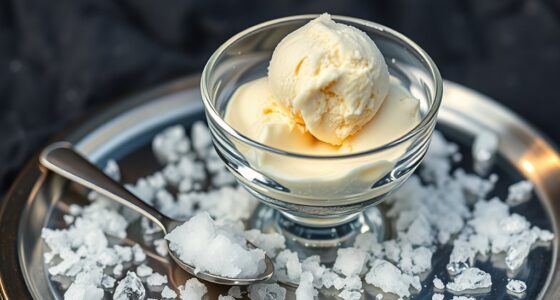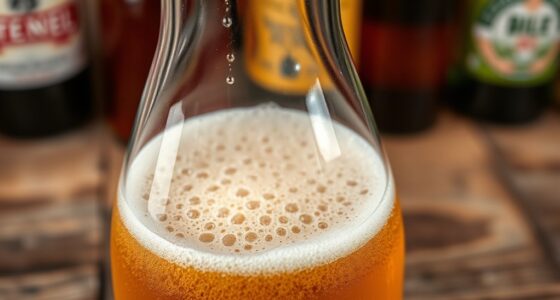Detergents clean your clothes by using surfactants with a hydrophilic head and a hydrophobic tail. These molecules break down oils and dirt by lowering surface tension and forming micelles that surround and trap grease and stains. The micelles keep dirt suspended in water, preventing it from settling back on fabrics. Understanding how surfactants work can help you get the most effective cleanliness—keep going to discover more about this fascinating process.
Key Takeaways
- Surfactants reduce water’s surface tension, allowing it to spread and penetrate fabric fibers more effectively.
- They break down dirt and oils by lowering interfacial tension, making stains easier to remove.
- Surfactants form micelles that encapsulate grease and dirt, suspending them in water for rinsing away.
- They emulsify oily soils, preventing re-deposition and ensuring thorough cleaning.
- Additional ingredients like enzymes and builders enhance stain removal and improve overall cleaning performance.
The Dual Nature of Surfactants

Surfactants play an essential role in cleaning clothes because of their dual nature. They’re surface-active agents, meaning they work at surfaces or interfaces to help remove dirt.
Surfactants have both hydrophilic (water-loving) and hydrophobic (water-hating) parts. The hydrophilic head interacts with water, while the hydrophobic tail bonds with oils and grease. This unique structure allows surfactants to bridge polar and non-polar substances, making them effective in cleaning.
Surfactants’ dual hydrophilic and hydrophobic parts enable effective cleaning by bridging water and oils.
They reduce surface tension, helping water spread and penetrate fabrics more easily. Common surfactants found in detergents include soaps, alkylbenzene sulfonates, and fatty alcohol ethoxylates.
Their molecular design enables them to stabilize emulsions and keep dirt suspended in water, making clothes cleaner and fresher after washing. Additionally, the effectiveness of surfactants depends on their color accuracy, which influences how well they remove stains and dirt from various fabrics.
How Surfactants Break Down Dirt and Oil

When surfactants interact with dirt and oil on fabrics, they work by reducing the interfacial tension between water and these contaminants. This makes it easier for dirt and oil to detach from fibers, as the surfactants disrupt the forces holding them in place. They cause a “rolling-up” effect, lifting dirt and oils off surfaces more readily. Lower interfacial tension allows water to penetrate oily soils, enhancing cleaning. Surfactants also emulsify oils by surrounding droplets with their hydrophobic tails, keeping them suspended in water and preventing re-deposition. Additionally, they form micelles that solubilize stubborn oils and dirt, making them easy to rinse away. This combination of effects ensures that contaminants are effectively broken down and removed during washing. Surfactants’ ability to form micelles is essential for removing even the most stubborn soils efficiently.
The Role of Micelles in Cleaning

Micelles play an essential role in the cleaning process by encapsulating dirt and oils within their structure. When your detergent reaches its critical micelle concentration (CMC), surfactant molecules aggregate into micelles, with hydrophobic tails inward and hydrophilic heads outward. This orientation allows the micelles to trap oily dirt inside their core, isolating grease from water. The oily particles attach to the micelle’s interior, preventing them from settling back onto fabric. During washing, micelles continually form and break apart, capturing dirt and releasing it into the water for rinsing. Their size and shape influence cleaning efficiency, helping greasy stains disperse and rinse away more easily. The formation of micelles is spontaneous due to molecular interactions. Understanding micelles’ role clarifies how detergents effectively lift and remove stubborn oils from clothes. Additionally, the surfactant molecules are designed to work efficiently at various water temperatures, enhancing their cleaning power under different washing conditions.
Additional Ingredients in Detergents and Their Functions

Additional ingredients in detergents, such as builders, enzymes, bleaching agents, and soil dispersants, play essential roles in enhancing cleaning performance. Builders like sodium carbonate soften hard water by binding minerals like calcium and magnesium, ensuring your detergent works effectively. Chelating agents, such as sodium gluconate, prevent mineral deposits from redepositing on fabrics. Enzymes target specific stains: proteases break down protein stains, lipases tackle fats and greases, and amylases handle starch-based residues. Oxygen-based bleaches, like sodium percarbonate, brighten fabrics and kill bacteria without damaging colors. Soil dispersants and anti-redeposition agents keep dirt suspended, preventing it from settling back on clothes. Fragrances add a fresh scent, while other additives like preservatives and fabric conditioners improve overall laundry results. Incorporating stain removal mechanisms helps optimize cleaning efficiency by actively breaking down different types of dirt and stains.
Types of Surfactants and Their Effects

Surfactants are the key ingredients that determine how effectively a detergent cleans your clothes. There are four main types, each with unique effects.
Anionic surfactants, like LABS and SDS, are most common and excel at removing oily dirt and clay by emulsifying soils so they rinse away easily.
Nonionic surfactants, such as alcohol ethoxylates, work well on oily stains and particulate soils, especially in automatic washers, and are less affected by water hardness.
Cationic surfactants, mainly used as fabric softeners, break down soil-water interfaces, helping fabrics feel softer.
Amphoteric surfactants adapt to different pH levels, providing gentle cleaning and foam stabilization.
Additionally, the interaction of surfactants with water properties can influence cleaning efficiency, highlighting the importance of understanding water hardness in laundry processes.
Combining these surfactants optimizes cleaning, rinsing, and fabric care, targeting a variety of soils and water conditions.
Environmental Considerations in Modern Detergent Formulations

Environmental concerns are increasingly shaping how detergents are formulated today. You mightn’t realize that traditional ingredients like phosphates cause water pollution, leading to harmful algal blooms and ecosystem damage.
Synthetic surfactants can harm marine life and often don’t break down easily. Fragrances, chlorine bleaches, and preservatives pose toxic risks to animals and plants.
Plus, high water content in liquid detergents adds to transportation emissions. To address these issues, manufacturers are shifting toward biodegradable surfactants like LABSA and SLES, which reduce environmental impact.
They’re also developing formulations from renewable resources, cutting down on toxins and waste. Innovations like concentrated detergents and eco-friendly packaging further minimize water and carbon footprints, helping you choose products that are effective while protecting the planet. Understanding surfactant biodegradability can guide consumers towards more environmentally friendly choices.
Frequently Asked Questions
How Do Surfactants Interact With Different Fabric Types During Washing?
You’ll notice that surfactants interact differently with various fabrics during washing. They emulsify oils and dirt on synthetic fibers by embedding hydrophobic tails into oily soils.
Meanwhile, on natural fibers, they help remove waxes and dirt, restoring softness. Cationic surfactants soften wool and cotton by neutralizing charges, making fabrics feel smoother.
Can Detergents Remove Stubborn Stains Without Damaging Clothes?
Did you know that over 80% of consumers struggle with stubborn stains? You can remove tough stains without damaging your clothes by choosing the right detergent.
Modern formulas use enzymes to break down stains at a molecular level, reducing the need for harsh chemicals. These enzymes target specific stains, while gentle surfactants lift and suspend dirt, protecting your fabrics.
With proper temperature and formulation, you get clean clothes that stay vibrant and intact.
What Are the Differences Between Powder and Liquid Detergents?
You’ll notice powder and liquid detergents differ in formulation, usage, and environmental impact. Powder is cost-effective and ideal for mud or grass stains but needs dissolving and doesn’t work well in cold water.
Liquid dissolves easily in all temperatures, pretreats stains, and handles grease better. It’s more expensive and can produce more plastic waste.
Choose based on your stain type, machine compatibility, and eco preferences for ideal cleaning.
How Do Water Temperature Variations Affect Cleaning Efficiency?
Water temperature plays a key role in cleaning efficiency. When you use hot water, your detergent activates fully, helping to remove tough stains and sanitize effectively.
Cold water is gentler and preserves fabrics but may not eliminate all soils.
Warm water offers a balance, improving cleaning while protecting delicate fabrics.
Adjusting the temperature based on your laundry needs can optimize cleaning results and save energy, benefiting both your clothes and the environment.
Are There Eco-Friendly Surfactants Available for Sustainable Laundry?
Eco-friendly surfactants are like gentle giants, offering sustainable options for laundry. You’ll find plant-based surfactants derived from coconut, palm, and olive oils that break down quickly and are biodegradable.
These alternatives reduce environmental impact, lower toxicity, and support eco-conscious choices. While they may cost a bit more, their performance and sustainability benefits make them a smart option for cleaner, greener clothes—helping you care for the planet with every wash.
Conclusion
Think of detergents as your clothes’ personal cleanup crew, with surfactants as the superheroes tackling dirt and oil. They work together like a well-oiled machine, forming micelles that trap grime and lift it away. By choosing the right ingredients, you’re ensuring your laundry gets a fresh start every time. So next time you toss in your clothes, remember—you’re releasing a tiny army of cleaning warriors ready to keep your wardrobe shining bright.









